PR Report: How to Write, Template & Example [2026]
Table of contents
PR professionals need a simple way to check the results of their work. Take Apple’s iPhone 17 launch as an example. Within days of the September event, it generated 13.6k mentions and 444M reach, peaking at over 210M on launch day alone. Sentiment held steady at 21% positive and only 4% negative, aligning with Apple’s overall brand perception.
This is exactly the type of data PR reports should surface: not just how much buzz there was, but where it came from, what tone it carried, and how it compared to the bigger brand picture.
Without monitoring and structured PR reporting, insights like these would be nearly impossible to capture.
- Are the numbers growing?
- Is your work affecting the company’s bottom line?
This information is crucial for your CEO, CMO, and other PR pros you work with.
In this post, I will guide you through the PR report world.
Hopefully, by the end of this read, you will be able to prepare an informative PR report that takes your communications efforts to the next level.
What is a PR report?
A PR report is a document that sums up your public relations efforts.
A well-done PR report will help you make more insightful business decisions and present your results to the C-level.
It’s essential to make PR reports at regular intervals so you always have a clear overview of your situation and how it changes.
What are the types of PR reports?
The type of reports and the way you create them depend on the target audience and your media coverage.
Managers or clients need a different type of PR report than the board of directors or investors.
Yes, monthly and quarterly reports are the most popular, but there are more kinds!
Perhaps a different type would be suitable for you?
Check the list below to find the best PR reports for you.
Here’s a list:
01 Monthly reports
Monthly PR reports will give you a general overview of the current situation of your brand.
What are the benefits of reporting often?
- You can examine the effects of your work on the spot and your current media coverage, then adjust your activities accordingly.
- You can also reallocate your resources to the plan that brings the desired results.
🔎 Who will benefit from monthly reports?
It’s a great PR report for all professionals who need to report to a supervisor or manager.
02 Quarterly reports
If the monthly report is a test, then the quarterly PR report is your end score. Quarterly reports will help you defend your results and tailor the overall PR strategy.
- You will be able to pinpoint the correlation between the dollars spent on your PR campaign and specific business outcomes, as well as the impact of press releases.
- Even if you engage in activities that don’t directly link to sales, you can explain the benefits to the brand you manage and check whether the media coverage aligns with the plan.
🔎 Who will benefit from reporting quarterly?
Quarterly reports are the ones your VP, CMO, or Senior PR professionals will require, but you (PR manager) will also likely use them, as they show how you’re doing.
PR reports are usually shared with stakeholders who are invested in PR efforts.
03 Annual reports
Annual reports are one of the most important PR reports you have to prepare. Why?
- Your boss will make budget decisions based on the data you include in the annual report.
- Annual PR reports summarize a year’s PR activities and performance metrics.
- If you require additional funds for tools, new team members, increased media coverage, or other resources – you can specify this in the annual report.
Don’t forget to mention the PR strategy and the expected outcome of the spending.
🔎 Who will benefit from the annual report?
Annual PR reports contain information important for CEOs, the board of directors, or investors.
They show the current PR performance, summarize collabs with media outlets, and include media monitoring stats.
04 PR Campaign report
Before you launch a public relations campaign, you need to create reports to define your goals.
- Your campaign report will state whether you achieved your goal and what you should improve before the next campaign.
- The frequency of PR campaign reports depends on stakeholders’ needs.
🔎 Who benefits from a campaign report?
Generally, the PR team. You should prepare PR campaign reports for your direct supervisor or CMO. Usually, the audience of the report depends on the size of the campaign.
If the campaign’s budget were big, more people would likely want to review the results.
05 Crisis report
Yep, we all wish it wasn’t true. But every brand is prone to crisis.
- Thanks to the PR crisis report, you can show how your department helped minimize the damage, change the narrative, and protect your brand reputation.
🔎 Who will benefit from a crisis report?
Crisis management is an opportunity for PR managers.
Manual PR reporting: 3-step tutorial
Once you decide what type of PR report you want to prepare and who the target reader is, you can get to work!
How to create a PR report?
Here’s a list of key points you want to include:
01 Check the volume of mentions
The volume of mentions shows you how many times the name of your brand, product, or service has been used online.
In theory, the higher the volume of media mentions, the better recognition your brand has.

It’s important to start your PR analysis by checking media mentions.
A sudden spike in the media mentions can either indicate that your PR campaign is working or that your brand is having a PR crisis.
In the first scenario, more people are becoming aware of your company, resulting in rising brand awareness levels.
That’s exactly what you can see in the screenshot above.
Duolingo did a campaign that went viral and created buzz all over the internet.
But how do you know it’s not the bad talk?
02 Conduct sentiment analysis
Sentiment will give the context you need to assess the impact of your public relations communications on your brand.
Whether it’s negative or positive.
How does sentiment analysis work?
Sentiment analysis categorizes the tone of coverage as positive, negative, or neutral, providing examples of key quotes or headlines to illustrate brand perception.
Sentiment analysis will help you spot any looming crisis and the next steps to counteract the effects. The process helps determine the most successful content and, ultimately, helps increase reach.

03 Elaborate on your performance
Reach is the metric that highly determines your performance.
It’s particularly important for various PR agencies that need to work on media relations.
Here’s how those metrics can be presented:
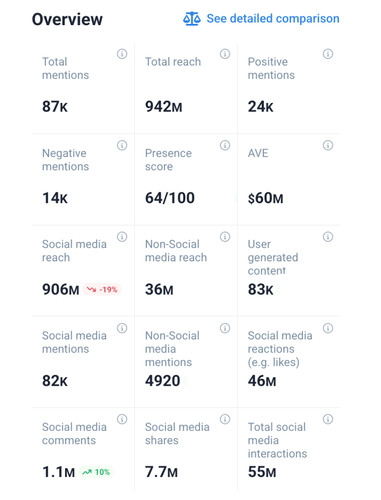
This analysis also shows how many people could have come into contact with your content.
From a PR perspective, reaching the right audience with the right message at the right time is a Holy Grail.
What to include in a PR report?
I asked an expert in this field – PR Manager, Marlena Stemler-Matysiak, to share her must-haves in PR reporting.
She admits:
But, she believes there are a few universal ones that always provide valuable insight into how visibility and image are developing.
Here’s the list with a quick note on why you should pay attention to this metric:
01 Volume of mentions
Usually, the more mentions, the better. We want to see consistent growth in this area. If there is none, it is worth reviewing the strategy.
However, it is important to remember that this is a very general indicator and does not determine the success of a campaign.
02 Most popular mentions
They show which comments about the brand have gained the most visibility.
It is worth monitoring this indicator to prevent crises and to identify opportunities for collaboration with the media or influencers.
03 The context of the discussion
That’s an important metric for content planning.
- What is our audience discussing?
- Are there any questions or topics that would be worth addressing in future publications?
An effective PR report combines hard numbers with qualitative insights to tell a complete story of the campaign’s performance.
04 Sentiment analysis
Involves researching the mood around the brand, which helps identify areas where customers are dissatisfied or experiencing difficulties.
If there are more negative mentions, you need to act quickly!
05 Influential sites
It is worth knowing what influential people or platforms are saying about the brand and shaping these messages by collaborating with them, for example.
Media coverage summary should include publication dates, outlet names, links to online articles, estimated reach, and top media wins.
PR report template
AI tools can help you generate PR report templates within minutes.
You can personalize them according to your needs and generate charts and insights within a few clicks.
I created the reports below, and it took me about 5 minutes.
And you can create one for your brand too.
Feel free to download them and check what they look like.
I didn’t apply any specific filters to them, but there’s a lot you can manipulate. For example:
- Sources included in the report
- The specific time frame
- The specific campaign overview
- & much more!
Plus, you can share this report with anyone you need with a simple link.
I honestly think it’s the best way to create a PR report!
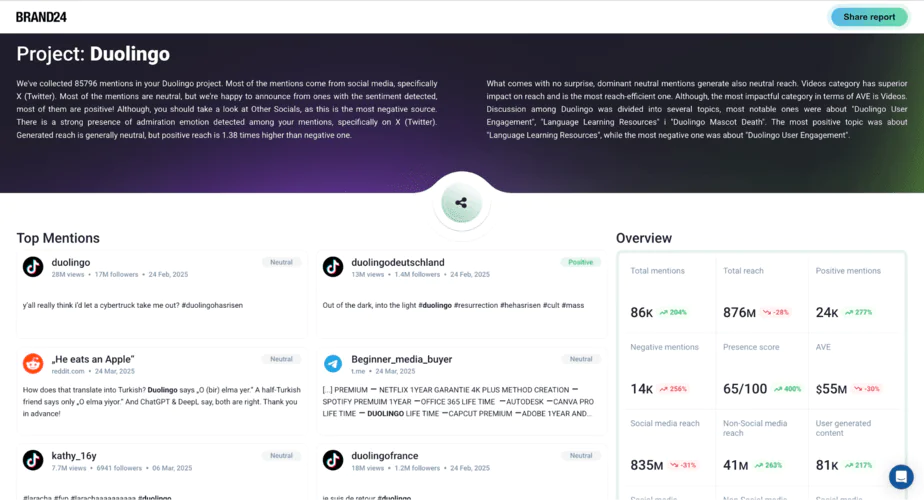
My tip: Use public relations software
Before you start any public relations campaign, you need to find the right public relations software.
Media monitoring tools help track brand mentions across various platforms.
An ideal tool will collect the data in real-time from various sources, including the web and social media platforms.
Moreover, the media monitoring tool should provide insights into what your marketing and communications department could use to improve your existing public relations campaigns.
Implementing a social listening tool into your marketing and communications tool stack will automate most of the process.
You can try one of these PR monitoring tools.
Public relations metrics
Many public relations software will automatically analyze the collected social media mentions.
A robust analysis section will save you a lot of time, make the results of your PR campaigns more manageable, and bring your public relations efforts to the next level.
What should the perfect PR analysis contain?
- The volume of mentions
- Sentiment
- Reach, both for social media and Web sources
- Social media engagement
- The context of the discussion
- Fully customizable PDF reports
- Comparison of two or more media monitoring projects
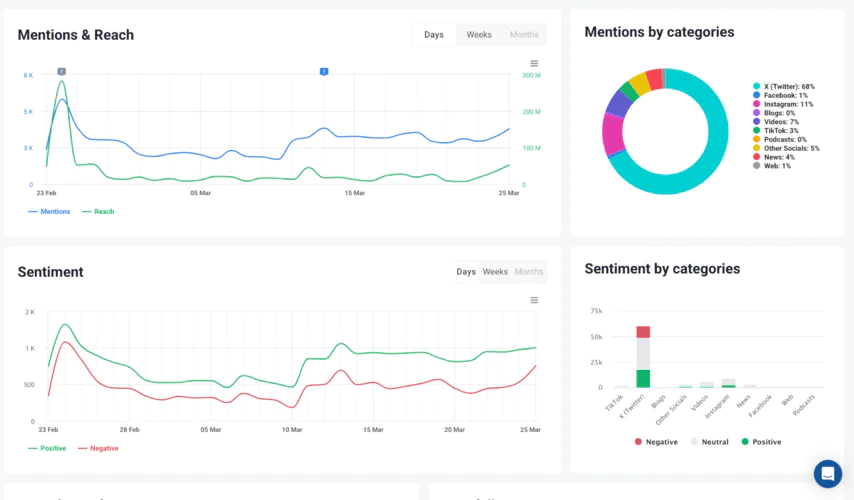
PR data sources
Apart from the analysis part of the results, you need to take a look at the sources of the data.
Some PR tools will focus on social media channels, others will cover only Web sources.
In my opinion, you should get data from all the sources, so that your marketing and communication can make the most informed decisions possible.
Campaign objectives should be SMART: Specific, Measurable, Achievable, Realistic, and Time-bound.
What are the PR report best practices?
You already know a lot about writing a PR report:
- You know the possibilities of AI tools.
- You know you should define an audience and determine the type of PR report.
- And have an overview of the key metrics that you need to track.
There are other PR reporting best practices and tips you should implement to succeed and show the ROI.
01 Clearly define the goals of the PR campaign
Your PR report will only be as good as your PR campaign. That’s why it’s crucial the clearly define the goals of the campaign before you start doing anything. In your reports, you need to present proof that your work is bringing substantial value to your clients’ businesses.
02 Public Relations KPIs
Before you start your PR reporting, you need to agree on key performance indicators with your client.
It’s important to be on the same page when it comes to KPIs so you can track the right metrics all the time. It’s important to start media monitoring before starting your campaign, as collecting historical data is expensive and not always accurate.
03 Visuals
The target audience of your reports is usually busy. To make your reporting more comprehensible, include some visual elements, for example, charts, graphs, or tables. Visuals will make it easier to prove the business value of public relations to the company.
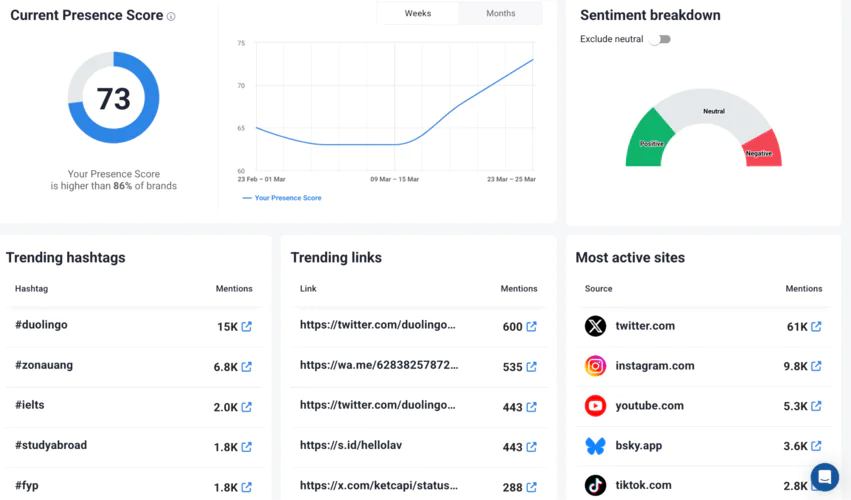
04 Write your recommendations
Preparing monthly reports gives you a unique competitive advantage. You have an overview of the data you can easily spot trends, identify the best performing content, and provide valuable feedback after special events and product launches.
That’s an opportunity to add a bit of investigative journalism to your work.
Spotting the insights allows you to provide valuable recommendations on adjusting your PR efforts to bring even more value to your marketing and communications efforts.
Plus, it doesn’t necessarily take much time.
You can ask AI for recommendations based on your performance data:
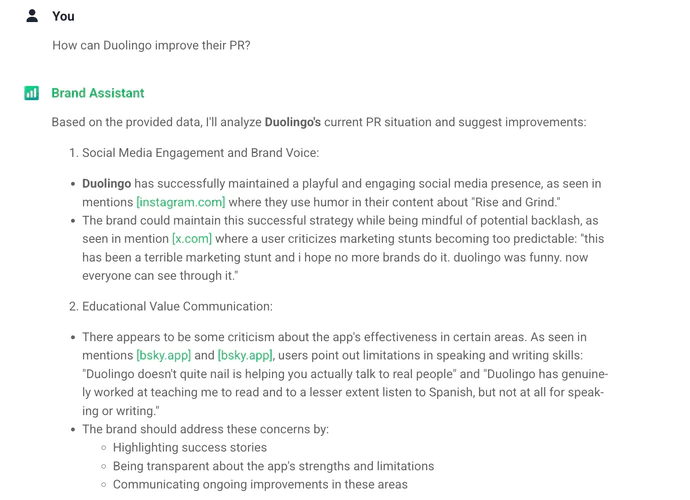
Conclusion
Hopefully, by now, you have all the necessary information to create reports that will summarize your PR efforts.
So – final checkpoint.
What should you take into account while preparing a report?
- Think about your audience. Who is going to read it? Your manager or one of the executives? Depending on the audience you choose, you will have to provide different pieces of information in your work.
- Agree on the business metrics and KPIs beforehand. You want to share the top news and show the value of your work. The public relations industry is a broad field, so it’s hard to stay focused when your executive or client focuses on different metrics.
- Choose a media monitoring tool. A well-chosen PR software will help you get insights to increase your media coverage.
- Provide your business recommendations. Reports should conclude with a forward-looking perspective that details how current activities will influence future projects and objectives.
Cause why even report when you don’t plan to take accountability after?
You can simplify the process and generate a report using AI. Start with a Brand24 free trial and make PR reporting simple!



